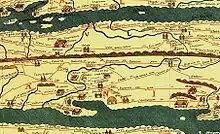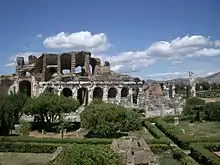Aequum Tuticum
Aequum Tuticum was a Roman vicus in southern Italy, about 35 km east-northeast of Beneventum. The site lies beside Saint Eleuterio hamlet, overlooking Miscano Valley at an elevation of 575 m, about 15 km north of the modern Ariano Irpino, within Irpinia historical district.[1] The vicus name is partly Latin (Aequum, meaning "plain", "flatland") and partly Oscan (Tuticum, "popular", "public").[2]
 | |
 Shown within Italy | |
| Location | Saint Eleuterio, Ariano Irpino (Province of Avellino, Italy) |
|---|---|
| Region | Campania |
| Coordinates | 41°14′32.3″N 15°5′54.5″E |
| Altitude | 575 m (1,886 ft) |
| Type | Settlement |
| History | |
| Periods | Roman Republic – Roman Empire |
| Cultures | Samnites – Ancient Rome |
| Management | Superintendence for Archaeological Heritage of Salerno, Avellino, Benevento and Caserta |
Aequum Tuticum was founded near the intersection of two ancient Roman roads: Via Minucia (expressly cited by Ovidius)[3] and Via Aemilia in Hirpinis, whose existence is attested by two 2nd century BC milestones (found in the nearby areas "Torre Amando" and "Camporeale Saint Lucia") showing the inscription "Marcus Aemilius Lepidus".[4] The vicus was first mentioned by Marcus Tullius Cicero in a 50 b.C. letter addressed to his friend Titus Pomponius Atticus;[5] he described the place (under the name of Equus Tuticus) as a regular stopping point along the route to Apulia.

At the time of Adrianus, when the vicus was a possession of the gens Seppia from Beneventum,[6] it became a relevant road junction[7] because the vicus lay at the crossroads between Via Traiana and Via Herculea.[8]
Near Aequum Tuticum, just to the north, a stretch of Via Traiana has been discovered along Miscano torrent, whereas two sepulchral areas show up to the south and west;[9] aerial photographs have also shown the route of Via Herculia.[10]
Archaeological excavations, carried out between 1990 and 2000, found wall structures and evidence from the Roman era such as ceramics, inscriptions, funerary steles and coins. The oldest complex appears to be a thermal structure dating back to 1st century. The central compartment, named frigidarium, shows up a mosaic in black and white tiles. There are also a series of 2nd century rooms arranged in rows in (maybe rooms used as a warehouse or shop).
The settlement suffered the damage from an earthquake in the second half of 4th century, but shortly afterwards a villa, showing a compartment decorated with a vast polychromatic mosaic, was installed above the older buildings.[11]

Aequum Tuticum, mentioned in Tabula Peutingeriana and Itinerarium Antoninum, was then abandoned by 6th century, presumably due to Barbarian invasions. The high-medieval sources mention the locality (probably already uninhabited) first as Casalis Janensis, and then as Saint Eleuterio, the latter being a name of Greek-Byzantine origin (at the end of 9th century Byzantine troops, coming from Apulia, had occupied Benevento, which they held for several years).[6]
However, there are traces of a resettling in the Middle Ages (12th century), when the ancient Roman walls were incorporated into those of a building forming part of the new inhabited hamlet also called "Saint Eleuterio" (not to be confused with the nearby modern Contrada Saint Eleuterio), then in turn abandoned.[12]
A collection of finds from Aequum Tuticum is kept in Ariano Irpino Archaeological Museum while several dozen inscriptions and architectural elements are collected in a lapidary inside the Villa comunale.[13]
References
- Provincia di Avellino (1998). Giuseppe Muollo & Paola Mele (ed.). Ariano Irpino, Città dei Normanni (in Italian). Viterbo: BetaGamma Editrice. pp. 5–7.
- Giacomo Devoto. Gli antichi Italici [The ancient Italics] (in Italian). p. 257.
- Marina Silvestrini (1997). Relazioni irpine dei Seppii di ordine senatorio e un'epigrafe eclanense per i mani di Gaio Cesare [Senatorial seppii relations with Hirpini, and a tablet from Aeculanum for Caesar's Manes]. p. 19.
- Italian Archeoclub (Casalbore branch) (1995). Campania Region, Cultural Service Center of Ariano Irpino (ed.). Progetto itinerari turistici Campania interna - La Valle del Miscano [Turistic routes Project "Inland Campania - Miscano Valley"] (in Italian). 2. Avellino.
- Marcus Tullius Cicero, "VI, 1, 1", Epistulae ad Atticum
- Gianfranco Stanco (2012). European Center for Norman Studies (ed.). Gli statuti di Ariano [The Ariano Statutes] (in Italian). Grottaminarda.
- Giuliano Volpe (1996). Contadini, pastori e mercanti nell'Apulia tardoantica [Peasants, shepherds and merchants in Apulia during the Late Antiquity] (in Italian). Bari. p. 72, reference 62. ISBN 8872281652.
- I Dauni - Irpini, la mia gente - la mia terra [Daunians & Irpinians: my people, my land] (in Italian). Naples: Generoso Procaccini. 1990. pp. 67–68.
- Soprintendenza per i Beni Archeologici di Salerno e Avellino. "Il centro di Aequum Tuticum" [The site of Aequum Tuticum] (in Italian).
- Giuseppe Ceraudo and Veronica Ferrari (2016). Un nuovo miliario dei Tetrarchi per la ricostruzione del tracciato della via Herculia in Hirpinia (a sud di Aequum Tuticum) [A new milestone of Tetrachs for rediscovering the route of Via Herculea in Irpinia (south to Aequum Tuticum)]. pp. 83–92.
- "Archemail - Il centro di Aequum Tuticum" [ArchaeMail - Aequum Tuticum center] (in Italian). Archived from the original on 2015-09-19.
- Nicola Flammia (1893). Storia della città di Ariano [The history of Ariano City] (in Italian). Ariano Irpino: Tipografia Marino.
- "In fase di allestimento il Lapidario di Aequum Tuticum: un giardino archeologico in Villa comunale" [Aequum Tuticum lapidarium under construction: an archaeological garden in a public park]. Città di Ariano (in Italian).


